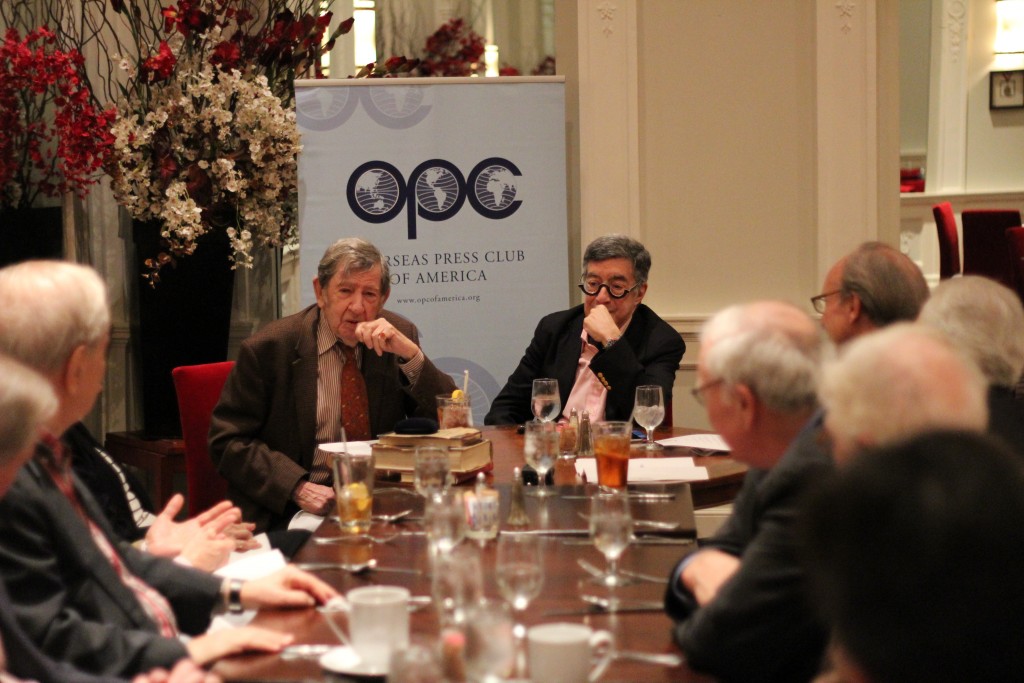When Washington Post reporter Karl Meyer first met Fidel Castro as a rebel leader in the Sierra Maestra mountains in the summer of 1958, his first impression was of a “slightly manic” man with what he described as an “enormous ego.”
“The impression you got from Castro was very much of a guy of overweening self-confidence and a sense of mission, and a sense of humor.”
“Like Donald Trump?” an attendee joked.
“The two would get along absolutely!” Meyer responded.
On Feb. 3, the OPC hosted a lunch in the Club Quarters dining room to talk about Castro’s legacy with the veteran reporter, who served on the editorial boards of The New York Times and The Washington Post. Former OPC President David Andelman, who worked for many years at The New York Times and World Policy Journal, moderated.
Castro and his army had been hiding and out of touch with the press for weeks when Meyer, still a cub reporter for the Post but slowly making a name as a Latin America specialist, contacted Castro’s movement in Washington and hatched a plan to meet “El Comandante” in Cuba.
Risking arrest if he’d been discovered as a journalist, Meyer slipped into the country under guise as a teacher and told his editors that he was going on a “vacation.”
When he was ready to depart for the mountains, he sent a telegram from Santiago to Post editor Bob Estabrook, which read “Dear Bob, business in our line is excellent. Have a possibility of making a deal, but involves seeing two brothers. And that means a side trip from Via Hermosa. Probably be out of touch for a week or more. Unless I hear from you within 48 hours, I will assume that you said ok,” he recalled the telegram reading. “And then I left immediately.”
Meyer got into a car with his guide and went through a series of checkpoints. They rode on horseback for three days through the Sierra Maestra before finally meeting Castro at his camp.
The two soon struck up a friendly conversation, in mixture of broken English and broken Spanish. He recalls Castro quoting Mussolini during their first meeting.
“‘You can make a coup with the army, or you can make a coup without the army, but you can never make a coup against the army.’” Meyer recalled Castro saying. “‘Karl, we’re proving Mussolini wrong.’”
Articles from his meeting was one of the only confirmations the rest of the world had that the rebel leader was still alive.
Meyer said Castro’s relations with America began to sour after the Eisenhower-Nixon administration, fearing Cuba’s Communist leanings and loyalty toward the Soviet Union amid a crackdown on dissidents, imposed a sugar embargo. Castro responded by nationalizing U.S. assets in Cuba, and later declared Cuba as a socialist enterprise and proclaimed himself a “Leninist-Marxist.”
But before these events, Meyer argues, Castro showed no passion for Communism and little interest in an alliance with the Soviet Union.
Meyer said Castro once told Jules Dubois, a Chicago Tribune correspondent, that he was not a Communist. “If I were, I would be brave enough to declare it publicly,” Castro said. “I have often told how I think, but I understand that you, as a U.S. journalist, have to ask about Communists.”
He adds that seeds of animosity were sown in April 1959 when Castro met with then-Vice President Richard Nixon (President Eisenhower dodged a meeting with the Cuban leader), who spent the whole meeting pressing Castro on his attitude toward Communism.
“Castro was fuming when he came out of that meeting. He felt humiliated,” Meyer said. “And he has used that word several times in his discussions of his relations with America.”
Karl Meyer’s followed up with a suggested booklist:
Overview: The master narrative is Hugh Thomas, Cuba: The Pursuit of Freedom (Harper and Row, 1971), a monumental volume, weighing in at 1,600 pages, from colonial beginnings through Castro’s rise and victory, by a distinguished British scholar. The subtitle condenses the theme; especially good on Cuba’s pseudo-sovereign status, post-San Juan Hill.
Castro himself: There are dozens of books, but I would start with Tad Szulc,Fidel: A Critical Portrait (Morrow, 1986), by a Times reporter, based on extensive interviews, well-sourced, and conditioned by the author’s ideological skepticism as a Polish-Jewish exile.
Castro, a leftist critique: A good solid book is Carlos Franqui, Family Portrait with Fidel (Random House, 1984), by an ex-Communist journalist, later key press aide to Fidel, with an eye-opening appendix on what U.S. journalists once wrote of the then-rebel hero, followed by data on Cuba’s economy. See also Theodore Draper, Castro’s Revolution: Myth and Reality (Praeger, 1962), an early X-ray view.
Bay of Pigs: Leading the way is Meyer and Szulc, The Cuban Invasion: The Chronicle of a Disaster (Praeger, 1962); followed by Haynes Johnson, The Bay of Pigs (Norton, 1964), based on reminiscences of survivors; and Peter Wyden, Bay of Pigs: The Untold Story (Simon and Shuster, 1979), a fluent recap. See also Arthur M. Schlesinger’s A Thousand Days (Houghton Mifflin, 1965). For Senator William F. Fulbright’s prescient dissent, see its inclusion in Karl Meyer, ed., Fulbright of Arkansas (Luce-McKay, 1963).
On Ernesto Guevara, key account in a vast literature is a memoir by Dolores Moyano, about his early years in Argentina.
On Herbert L. Matthews, see his memoir, Revolution in Cuba (Scribner’s, 1975). The extensive literature on Cuban Missile Crisis defies easy summary, but do consult Franqui, op.cit., for an internal Cuban view. On culture and leftist romanticism, I did not have a chance to single out The New Yorker’s Alma Guillermoprieto’s Dancing in Cuba (Pantheon, 2004); and on overall past U.S. hemisphere policy, be sure to consult my old friend and comrade-in-scribbling, Henry Raymont’s Troubled Neighbors: US-Latin American Relations from FDR to the Present (Westview, 2005).
Click on the window below to watch video clips from the program.

